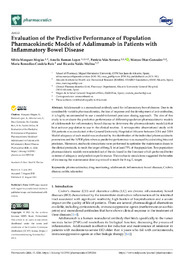Please use this identifier to cite or link to this item:
https://hdl.handle.net/11000/34574Full metadata record
| DC Field | Value | Language |
|---|---|---|
| dc.contributor.author | Marquez-Megias, Silvia | - |
| dc.contributor.author | Ramon-Lopez, Amelia | - |
| dc.contributor.author | Más-Serrano, Patricio | - |
| dc.contributor.author | Diaz-Gonzalez, Marcos | - |
| dc.contributor.author | Candela-Boix, Maria Remedios | - |
| dc.contributor.author | nalda-molina, Ricardo | - |
| dc.contributor.other | Departamentos de la UMH::Ingeniería | es_ES |
| dc.date.accessioned | 2025-01-16T12:46:32Z | - |
| dc.date.available | 2025-01-16T12:46:32Z | - |
| dc.date.created | 2021-08 | - |
| dc.identifier.citation | Pharmaceutics 2021, 13, 1244 | es_ES |
| dc.identifier.issn | 1999-4923 | - |
| dc.identifier.uri | https://hdl.handle.net/11000/34574 | - |
| dc.description.abstract | Adalimumab is a monoclonal antibody used for inflammatory bowel disease. Due to its considerably variable pharmacokinetics, the loss of response and the development of anti-antibodies, it is highly recommended to use a model-informed precision dosing approach. The aim of this study is to evaluate the predictive performance of different population-pharmacokinetic models of adalimumab for inflammatory bowel disease to determine the pharmacokinetic model(s) that best suit our population to use in the clinical routine. A retrospective observational study with 134 patients was conducted at the General University Hospital of Alicante between 2014 and 2019. Model adequacy of each model was evaluated by the distribution of the individual pharmacokinetic parameters and the NPDEplotswhereaspredictive performance was assessed by calculating bias and precision. Moreover, stochastic simulations were performed to optimize the maintenance doses in the clinical protocols, to reach the target of 8 mg/L in at least 75% of the population. Two populationpharmacokinetic models were selected out of the six found in the literature which performed better in terms of adequacy and predictive performance. The stochastic simulations suggested the benefits of increasing the maintenance dose in protocol to reach the 8 mg/L target | es_ES |
| dc.format | application/pdf | es_ES |
| dc.format.extent | 13 | es_ES |
| dc.language.iso | eng | es_ES |
| dc.publisher | MDPI | es_ES |
| dc.rights | info:eu-repo/semantics/openAccess | es_ES |
| dc.rights | Attribution-NonCommercial-NoDerivatives 4.0 Internacional | * |
| dc.rights.uri | http://creativecommons.org/licenses/by-nc-nd/4.0/ | * |
| dc.subject | pharmacokinetics | es_ES |
| dc.subject | drug monitoring | es_ES |
| dc.subject | adalimumab | es_ES |
| dc.subject | inflammatory bowel diseases | es_ES |
| dc.subject | Crohn’s disease | es_ES |
| dc.subject | colitis | es_ES |
| dc.subject | ulcerative | es_ES |
| dc.subject.other | CDU::6 - Ciencias aplicadas::62 - Ingeniería. Tecnología | es_ES |
| dc.title | Evaluation of the Predictive Performance of Population Pharmacokinetic Models of Adalimumab in Patients with Inflammatory Bowel Disease | es_ES |
| dc.type | info:eu-repo/semantics/article | es_ES |
| dc.relation.publisherversion | https://doi.org/10.3390/ pharmaceutics13081244 | es_ES |

View/Open:
Artículo 2 (1).pdf
1,29 MB
Adobe PDF
Share:
.png)
